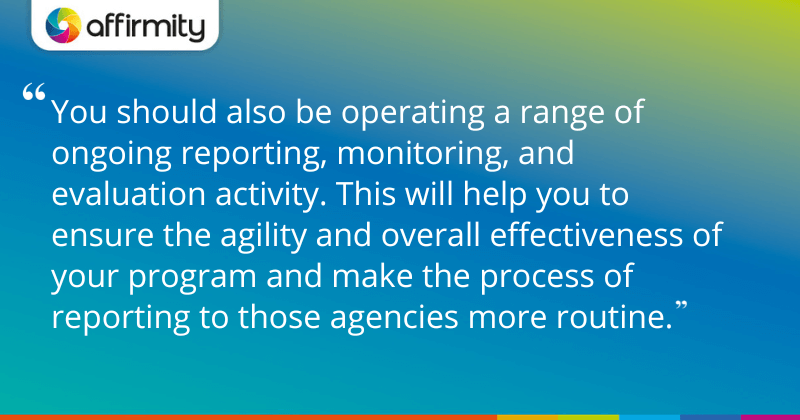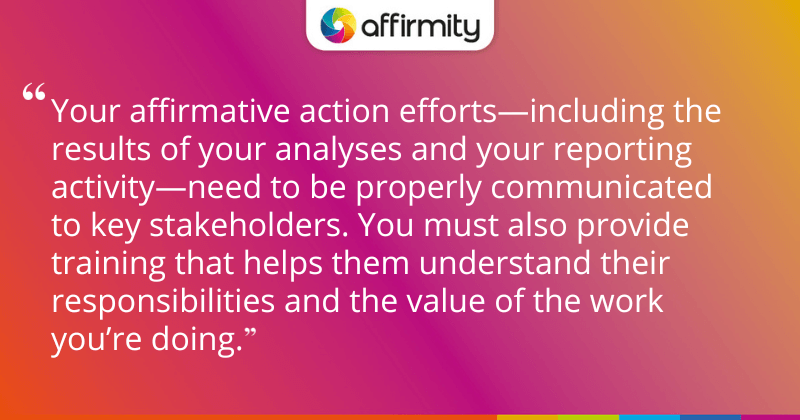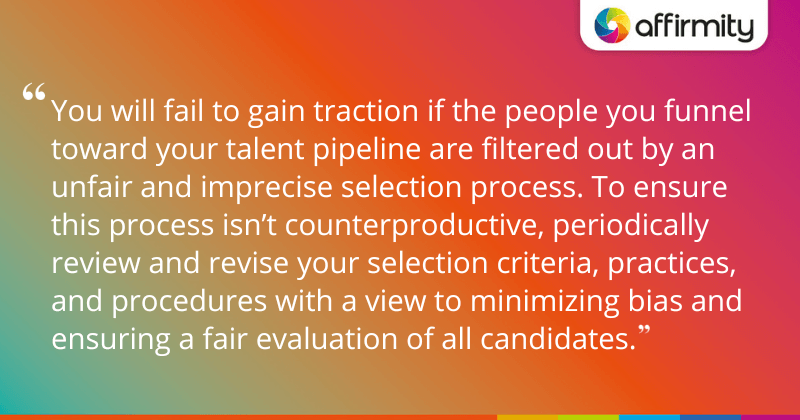What does a typical year have in store for a compliance professional? Building affirmative action plans and executing programs involves a lot of different moving parts. In this article, we’ll talk you through some key activities in the affirmative action calendar, from project kick-off to monitoring, evaluating, and communicating about your plan goals.
Kicking Off Your Project, Plan, and Policy Development
Ahead of each new reporting year, compliance professionals will want to assemble their project teams and schedule a kickoff meeting. This meeting should:
- Define plan structure(s)
- Discuss data specifications
- Identify additional data fields and reporting requirements
- Decide on a report distribution process
From here, the project team’s responsibilities will include:
- Authoring of (or amendments to) the full, written affirmative action plan. This should outline the organization’s commitment to equal employment opportunity, as well as diversity and inclusion.
- Documenting internal policies and practices supporting the affirmative action plan and the organization’s commitment to equal employment opportunity.
- Creation of checks and balances to ensure that the plan aligns with the full range of local, state, and federal laws governing affirmative action and other responsibilities.
- Developing specific actions with the purpose of:
- Identifying problem areas
- Addressing inequities
- Maintaining and updating policies and practices
- Self-auditing internal procedures
- Training employees
REACT TO RECENT AAP CHANGES | ‘New OFCCP Pay Equity Reporting Requirements: Your Analysis Options for Mitigating Risk’

Digging Into Your Data and Performing a Statistical Analysis
Once your team has met and your plans and policies have been defined, you’ll want to launch into a comprehensive analysis so you can better understand your current workforce position. This will give you a stable basis for analyzing the effectiveness of your program. You’ll need to:
- Create an employee snapshot that accurately records your current US domestic representation
- Establish job groups or job families for the purpose of comparing similar jobs when conducting your data analyses
- Conduct a comparison of your representation versus current labor market availability
- Perform a compensation analysis using one or more of the following methodologies:
- 2% or $2,000 tipping test
- OFCCP cohort analysis
- Pay equity analysis
- Regression analysis
- Examine selection rates across a range of employment activities (hires, promotions, terminations, etc.)
This will also be a period in which you should review your data files for completeness, perform reconciliations, and clarify any questions that emerge regarding your data.
Researching and Establishing Your Benchmarks and Goals
It won’t be possible to finalize your plans without first assembling your benchmark data and setting appropriate goals based on that data in conjunction with your workforce metrics. Federal agencies will set benchmarks for certain groups at specific levels, as detailed below. For the remainder, you’ll need to look at appropriate availability data for the areas in which you operate. Key tasks will include:
- Setting specific job-group-level placement goals for females and minorities in underrepresented areas according to your internal and external availability data
- Identifying instances where job group representation for individuals with disabilities is lower than 7%, as per the aspirational goal set by Section 503
- Tracking protected veteran hiring against the VEVRAA Hiring Benchmark for your current reporting year
Keeping Records, Reporting, Monitoring and Evaluating
While your priority will be to prepare any reports required by a range of regulatory agencies as per relevant laws, you should also be operating a range of ongoing reporting, monitoring, and evaluation activity. This will help you to ensure the agility and overall effectiveness of your program and make the process of reporting to those agencies more routine.
You should maintain accurate and up-to-date records of workforce data, recruitment activities, employment transactions, and your progress toward your affirmative action goals. Then you’ll need to:
- Regularly assess the effectiveness of your affirmative action initiatives and adjust them as necessary
- Review placement goal progress annually and during the plan year
- Address areas of adverse impact you uncover, performing additional analysis as required
- Monitor and evaluate the impact of your policies and practices
- Perform internal audits in order to ensure that you understand what the agencies may question in the event of a formal audit
- Review compensation and compensation practices, including:
- Ensuring the accessibility of appropriate documentation and support that will help you explain pay difference as needed
- A proactive approach to addressing areas of concern, including plans to remedy disparities
GO DEEPER ON DATA | ‘Incomplete, Inaccurate, Inconsistent: How the 3 “I”s Sow Chaos in Your Affirmative Action Data’

The Other Ongoing Activities You’ll Be Doing Year-Round
In addition to your year-round reporting, monitoring, and evaluation responsibilities, compliance professionals have a range of other tasks throughout the year.
Communicating With the Business and Providing Training
Your affirmative action efforts—including the results of your analyses and your reporting activity—need to be properly communicated to key stakeholders. You must also provide training that helps them understand their responsibilities and the value of the work you’re doing. Some key activities you can expect to perform include:
- Providing and publicizing channels through which employees can express their concerns or report discrimination
- Establishing transparency and accountability by communicating your affirmative action efforts to employees, stakeholders, and the wider public
- Conducting EEO, Affirmative Action, Section 503, and Federal Acquisition Regulations (FAR) training for management, recruiters, and other employee groups
- Delivering additional training as required by industry-, local-, and state-level laws
- Supporting overall inclusion efforts with appropriate DE&I training
LEARN MORE ABOUT THIS TOPIC | ‘What Are Your Training Obligations As a Federal Contractor?’
Outreaching and Exploring Avenues for Recruitment
While making internal improvements to your processes and to how everyone understands your workforce’s current position will help you make progress toward your goals, you also need to be proactive about attracting a steady flow of suitable candidates. Outreach and good faith efforts are expected activities for every federal contractor, and an essential point of leverage for your program. Therefore, you’ll need to:
- Implement targeted outreach to underrepresented groups, including organizations focused on protected veterans and individuals with disabilities
- Establish partnerships with educational institutions and diversity-focused organizations
- Continuously evaluate the recruitment sources and methods you use in order to validate them, ensure maximum effectiveness, and prove they’re adding value
Revisiting Your Talent Lifecycle Processes
Your program will likely fail to gain traction if the people you funnel toward your talent pipeline are filtered out by an unfair and imprecise selection process. To ensure this process isn’t counterproductive, you’ll need to periodically review and revise your selection criteria, practices and procedures with a view to minimizing bias and ensuring a fair evaluation of all candidates. You should also:
- Review job descriptions to ensure that the stated qualifications and physical requirements are accurate, up-to-date, and relevant to the job
- Provide equal opportunities for training, advancement, and promotion
- Review selection rates for hires, promotions, and terminations to address adverse impact

Dates You’ll Want in Your Diary (But Be Warned: Many of Them Move!)
Ideally, we’d love to give you a long list of dates, telling you when exactly each of the many federal-, state-, and local-level reports are due, or when audit activity is likely to take place. Unfortunately, one of the realities of being a compliance professional is that a not insignificant number of these dates can vary greatly from year to year!
This is one of the reasons why so much of the year we’ve described is filled with ongoing activity—you should be in the position to pull data and respond accurately to a variety of requests whenever they fall.
When creating your own pathway calendar, be sure to research (and sign up to be alerted about) the following dates:
- EEO-1: Since 2018, EEO-1 collection has fallen in a range of different months of the year, including March, April, and October.
- AAP Certification: AAP Certification: Contractors must certify annually via the OFCCP contractor portal. In 2024, the portal will open on April 1, and the deadline is July 1.
- VETS 4212: The deadline has reliably been September 30.
- California Pay Data Reporting: Second Wednesday in May.
- Other state-specific reporting:
- Illinois (Equal Pay Act)
- Minnesota
- New Jersey
- New York
- Ohio
- Wisconsin
Learn About This Topic Via Video
Watch this guide for an easy-to-follow summary of the 7-part pathway to affirmative action success.
Get help with any aspect of Affirmative Action preparation and data handling by contacting us today at affirmity.com/contact-us/
About the Author
Amanda Carcaterra is a Senior Business Consultant at Affirmity. She works with clients to ensure compliance with Affirmative Action regulations and provide assistance for their Diversity programs. She has worked in the Affirmative Action and Diversity sector for close to 20 years—10 of which were with a major airline, heading up its HR Compliance department. This role involved managing their Affirmative Action, Diversity, ADA accommodation, and background and fingerprint screening programs. She was instrumental in enforcing the organization’s Affirmative Action Programs and gaining leadership buy-in by utilizing AAP metrics to strengthen diversity.
